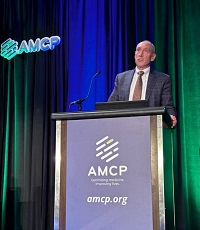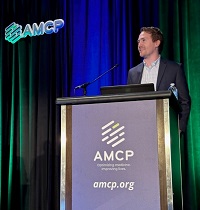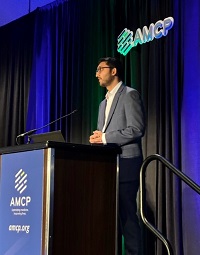Perspectives
AMCP Nexus 2023 Live-Blog: Day 2 Collection
October 18, 2023

Pat Gleason, Assistant Vice President, Health Outcomes
Behind the Research with Pat Gleason and Landon Marshall
As AMCP Nexus 2023 winds down, Pat Gleason, PharmD, Assistant Vice President of Health Outcomes, and Landon Marshall, PharmD, Health Outcomes Research Principal, close out the show with their session, “Gene Therapies: Forecasting Potential Candidates Using Integrated Medical and Pharmacy Claims Data.”
As noted throughout the conference, access to additional data resources will pave the way for new therapies. This very same concept holds true for the dynamic space of gene therapies, which is a technique that modifies a person’s genes to treat or cure disease. It’s an exciting, albeit expensive frontier in medicine.
“It’s important from a budget standpoint for prepare for these [expensive] ‘lighting strikes,’” Gleason explained. “We need to be ready… and to share and educate.”
There are dozens of therapies in the gene therapy pipeline, and the market has exploded since 2021. And we expect substantial spend in the next 10 years, Gleason noted, particularly with some therapies with a one-time cost in the range of millions of dollars. The challenge will be for organizations to come up with alternative payment models to solve the affordability problem of these therapies. Forecasting gene therapy candidates may help find a way forward.

Landon Marshall, Principal Health Outcomes Researcher
Prime has been forecasting gene therapies for five years, and the organization has learned a lot from this, Marshall shared. The classic forecast generally considers three characteristics: an anticipated price point, the curative impact, and one-time administration of the therapy. For the sake of this discussion, gene therapies do not include CAR-T therapies, as reviewed during yesterday’s session. As Marshall explained, putting a definition — or guardrails — around what is defined as a gene therapy is key.
Real-world utilization and safety data also lends insight when attempting to forecast these therapies, and as more enter the market, it becomes easier to develop a forecasting model based on what’s been observed before. The key is to revisit the analytics as new therapies are announced or are entering the market. And as gene therapies are developed for more prevalent conditions, like sickle cell anemia, they may have a significant cost impact.
There are four key steps in operationalizing a forecast model including: defining the therapy, the regulatory status and up-to-date data — including manufacturer and clinical reports — and an analytics framework. This last step is the most involved, Marshall noted, which includes building algorithms that can effectively manage data and records in a system, such as gender and age, cost of care/resource utilization, and reference code lists.
The final step is producing the forecast — or final report — to properly leverage the information, assess risk and predict potential gene therapy candidates. Partnerships with manufacturers are also important, as they also have access to data on new and emerging therapies that may defy definition. But the key is to keep an eye out and familiarize yourself with clinical trials of new products and treatments, Marshall remarked.
“We learn something every week,” he said.

Prerak Parikh, Director of Specialty Clinical Solutions
Behind the Research with Prerak Parikh
It’s day two of sessions at AMCP Nexus, and Prerak Parikh, PharmD, Director of Specialty Clinical Solutions, got things rolling as speaker at the session, “Biosimilar Operational Readiness: Managed Care Stakeholder Response to Market Expansion Impact.”
As more biosimilar therapies enter the market, and with even more in the pipeline, the health care industry, and patients, will have access to lifesaving medications at potentially lower cost. But how might managed care stakeholders respond? The answer is continuing to evolve.
In a poll at the top of the session, nearly two-thirds of attendees noted that they were either “slightly confident” or “not confident” addressing the benefits and challenges related to biosimilar expansion.
With the launch of biosimilars in 2015, the industry has seen rapid adoption of these products with compelling cost of care metrics and competition. The Inflation Reduction Act has only shifted the landscape further, with additional pricing impacts that make them even more attractive for patients.
Affordability, access and choice are key pillars to consider for members, providers, facilities and pharmacies, but the market will only be supercharged as new data on biosimilar switching becomes available. In fact, initial data favors the ability of patients to perhaps switch or substitute products with minimal health impact.
This meant payers must stay nimble, and as Parikh noted, Prime/Magellan Rx has expanded its own biosimilar programs. The ability to adjust to changes in the marketplace has meant that some biosimilars have been able to claim significant market share over the reference product. In a key example Parikh explains, one biosimilar product had 90% of the market share in 2022 over the reference product’s 10%.
While he notes that there’s some hesitancy among providers, this is an ideal time to educate and provide more data.
“While it’s hard to predict what will happen, the good news is that pricing impacts and interchangeability status is improving, which leads to better access,” Parikh explains.
Related news
Perspectives
July 25, 2024
Quarterly Drug Pipeline: July 2024
Clinical insights and competitive intelligence on anticipated drugs in development
Perspectives
July 22, 2024
Oncology Insights: 2024 ASCO Annual Meeting key findings
Findings from this year’s American Society of Clinical Oncology (ASCO) Annual Meeting will likely lead to clinical practice changes and U.S. Food and Drug Administration (FDA) drug approvals or expansions
Perspectives
July 16, 2024
LISTEN NOW: Beyond the business – Stories of corporate kindness | Pharmacy Friends Podcast
In this episode, we talk about how our employees' help goes beyond our work in health care, aiding in philanthropic efforts